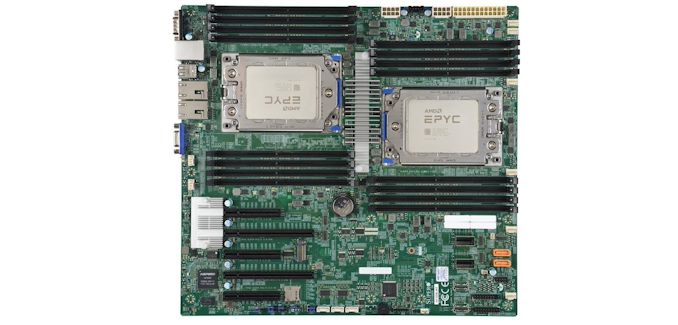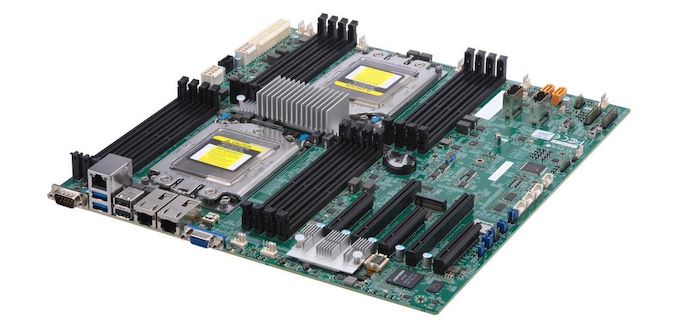The Supermicro H11DSi Motherboard Mini-Review: The Sole Dual EPYC Solution
by Dr. Ian Cutress on May 13, 2020 8:00 AM EST- Posted in
- Motherboards
- AMD
- Supermicro
- Naples
- EPYC
- 10GbE
- Rome
- H11DSi
H11DSi Conclusions
The ability to provide a suitable recommendation on a product is stifled when it turns out to be the only one available for a given market. I was surprised when I started doing research on dual socket EPYC solutions as to just how few motherboards were available. The fact that the number was one was even more dumbfounding – is there really next to no market for custom off-the-shelf built dual socket EPYC systems? Over the years we’ve seen a plentiful number of dual socket Xeon offerings for each generation, but it is perhaps that the market is still getting used to EPYC is why the options are limited. In a similar line, only four single socket options exist as well.
So despite the Supermicro H11DSi and its derivatives being the only option available, if you need it then there is no other question. But if the option is between this and perhaps going to two single socket systems, it still begs the question as to whether it is good motherboard to invest in. On paper, ~$680 for a dual socket EPYC board seems like a reasonable price.
First, let us start with some of the failings. Personally I felt that the lack of fan control support was a big let-down, especially if this is a motherboard that might find its way into desktop-class chassis for workstations. The only way to access the fan control is through the web-interface IPMI, and the options are extremely basic.
The other issue on the board is simply one of layout – due to board limitations there isn’t much that can be done here, but ultimately the second CPU is underutilized. Out of the 64 PCIe lanes that it offers (the chip has 128, but 64 are being used for CPU-to-CPU links), only 8 are used for an external PCIe device. It’s almost as if this motherboard needs a separate add-on device to be able to use more of what the hardware can offer. This brings me back around to the conclusion I made on the first page – this motherboard is likely more for CPU computational use cases than anything that needs to fully use the IO of the hardware.
On the positives, the power cable layout is good for most systems, as I’ve experienced some bad power connector placement in similar boards for older systems. Having 8 fan headers, despite what I’ve said above, is a good thing as well. We successfully booted both from SATA and NVMe, and accessing IPMI through a board-specific password is something we expect all future server products to adhere to in the future. We had no issues with the latest high-end processors, the 7F02 series, as well as some of the high core count ones running some super high density memory. That price isn’t too bad either, especially if this is going to be a compute focused system with high-value CPUs inside.
It is difficult not to sound downtrodden when you have to write 'it gets recommended by default, because it's the only option'. Users looking at EPYC systems might find that single socket deployments might be in your favor - the EPYCD82T that we reviewed previously costs around the same price as this 2P Supermicro board, but makes a lot better use of the IO per socket. The Supermicro H11DSi has density in its favor, and will cater to that crowd, but there are a number of decent single socket offerings that should be explored as well.












36 Comments
View All Comments
eek2121 - Wednesday, May 13, 2020 - link
A though I had: It would be nice if PCIE latency could be measured going forward.headeffects - Wednesday, May 13, 2020 - link
Can you explain a bit why ECC is less useful now than on the past? I’m curious.AntonErtl - Thursday, May 14, 2020 - link
All sTRX4 (Threadripper 3000 socket) boards listed on https://geizhals.at/?cat=mbstrx4 are listed as supporting ECC. Even a number of mainstream desktop boards (primarily from Asrock and ASUS) support ECC and we have built servers with them, and we have tested that ECC works.Micronsystems - Friday, May 15, 2020 - link
Much informative blog.Reach Micronsystems for the best<a href = "https://www.micronsystems.co.in/">desktop rental in chennai</a>
fakemoth - Friday, May 15, 2020 - link
Long time lurker here, love Anandtech. I had to register an account for this article in order to join the disappointment gang: there is a ridiculous low number of ATX formats options for AMD EPYC, and when talking Rome and PCI gen4, even lower. Found this the hard way: I hardly managed to get a Gigabyte MZ32-AR0 after months of waiting in vain for Supermicro to release some standard ATX/eATX with PCI gen4. Nowadays they seem to have some H12 models out, but of course those are nowhere to be found. If you want to buy one that is.Problem is: now there is no new dual socket option! Exactly when I bought a 7402 Epyc, not a P part as usual... Supermicro is simply missing the server CPU party of the decade. We hope that the press can push things in the right direction, as it is not the time for big manufacturers to arbor the Intel fanboy flags. They did it for a very boringly long time, I just can't believe there isn't the slightest interest in the Rome platform. Because that's what it is: an astounding lack of interest and a very obtuse technology angle, that awful "partnership" inertia that plagues the server/workstations market. It seems that being future proof is a crime in this area.
It speaks for itself: we are reading here a review of a board that is 2 years old and got a revision half a year ago... Yeap, the cheapo BIOS revision, that one.
One thing about the article: the BIOS can't usually be updated via IPMI for Supermicro boards without a license. Only the firmware. Is this still the case or not?
Thank you Anandtech for reviewing enterprise, but standard formats (there shouldn't exist anything else, but that's just me)! Supermicro makes cool tech and I own a bunch, but sometimes, man...
JustTheInductions - Friday, May 15, 2020 - link
PCIe Gen 4. Supporting the feature set of the expensive CPUs you plan on utilizing is a necessity. Support a competitor to SuperMicro to get the board manufacturers to provide more support, AMD. We all know competition engenders motivation to get off one's arse . . .Deicidium369 - Monday, May 18, 2020 - link
Which competitor is that?JustTheInductions - Friday, May 29, 2020 - link
Probably ASRock Rack.kwinz - Saturday, May 16, 2020 - link
E-ATX is just a painful form factor for a dual socket EPYC. Think of all the PCIe lanes that you can never use.Deicidium369 - Monday, May 18, 2020 - link
Even if all the slots were available - you still would not have a use for 128+ lanes. I know the big number is enticing - but in reality - like the 16C desktop CPUs - it's just a marketing gimmick. It's like having a car with 3000HP and it only gets driven in Manhattan - Cool that you have 3000HP, but in reality, not much use.